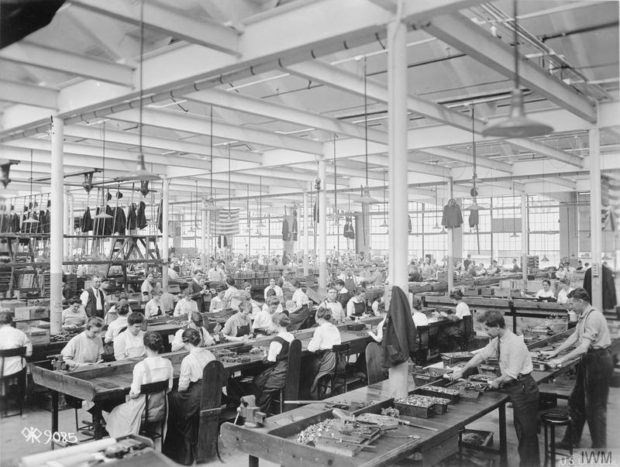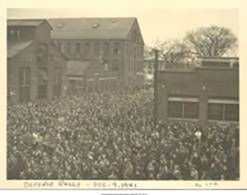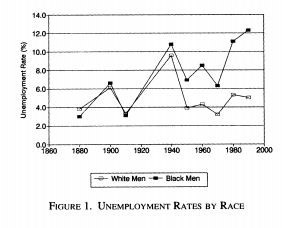How To
Classroom Setup
Students will brainstorm in small groups using charts, primary sources to answer the supporting and compelling questions. They should have access to the internet.
Activity 1
Students will brainstorm in small groups about what makes a good/bad job. They will report out to the larger group. Use the following prompts:
- What conditions would you like in your place of employment?
- What conditions would make you dislike your place of employment?
Possible Answers
- Factors that give a worker power in the workplace: Control pace, make a product, pride, have breaks, control the pace of work, having a skill, reasonable hours, good pay, way to channel grievances to employer
- Factors that take away power in the workplace: Don’t control the pace of work, make only a small part of the product and never see final product, no breaks or talking to co-workers, dangerous, too close supervision, hours too long, wages too low
Activity 2, Analyzing a Photograph in Small Groups
Study the photograph taken of women workers at Colt’s Firearms during World War I. What makes this job look like a good one? What would be difficult about this job?

General view of a section of the Colt’s automatic firearms plant in Hartford, where many American women took the places of men who had joined the services, April 1918. Connecticut State Library
Ask students: if a worker’s working conditions are not good, what are his or her choices?
Record answers that reflect the following and more:
- Quit and get another job
- Grin and bear it
- Complain directly to your employer with fear of being fired
- Join together with other workers in a group to form a union that will collectively bargain with their employer
Read about the history of Colt’s Firearms in Hartford from the historical context above and from primary and secondary sources provided in the links in the table below. Look at the first 3 primary sources in the Google Slides presentation. What factors helped give workers power? What factors gave employers power? Why did the workers want to join a union?
In the chart below you will find 15 factors which can aid the workers, the employers, both or neither. Give reasons why you think this factor helps or hurts in the boxes. Sources for information are linked to the factors.
|
1 |
Context of the Strike |
Helps Workers Unionize |
Gives Power to Owners |
|
2 |
|
|
|
|
3 |
Unemployment Rate
|
|
|
|
4 |
Low Unemployment
|
|
|
|
5 |
The Press
|
|
|
|
6 |
Ethnic groups who could not speak English |
|
|
|
7 |
Women workers who did not get paid as much as men |
|
|
|
8 |
Company union - Organization for workers established by the company |
|
|
|
9 |
Craft Union - Union in which skilled workers band together for better hours, pay and working conditions |
|
|
|
10 |
Industrial Union - All workers in the same industry belong to the same union |
|
|
|
11 |
Paternalism and the Company Town - the employer provides services: housing, sports |
|
|
|
|
Leagues - Musical bands for the workers |
|
|
|
12 |
Fair Labor Standards Act - sets minimum wage at 40 cents per hour 1938 |
|
|
|
13 |
Patriotism |
|
|
|
14 |
House Un-American Activities Committee - Rooting out Communists in unions |
|
|
|
15 |
Globalization |
|
|

Analyze the photograph “Strike at the Colt’s Firearms factory.” What are these strikers, who are in Washington, D.C. thinking caused this strike? In your research, how important a role does the government play in workers’ rights? This is slide 5 in the Google Slides presentation.


A bird’s-eye view of “Coltsville,” 1877. This industrial village along the Connecticut River in Hartford included Samuel Colt’s famous onion-domed factory (foreground), and behind it, workers’ housing, a baseball field, and a church. To the right of the armory and below the church is Charter Oak Hall, where workers could engage in numerous leisure activities. A detail from the lithograph “City of Hartford” (1877) by O. H. Bailey, courtesy of The Connecticut Historical Society.
To use Katz and Wagner’s language, the Colt Armory was the “anchor firm” of the Hartford “innovation district,” which grew to include the Weed Sewing Machine Co., the Pope Manufacturing Co. (bicycles, automobiles), both the Underwood and Royal Typewriter companies, and Pratt & Whitney (machines tools), the last of which was a spin-off founded by two former Colt machinists. http://invention.si.edu/rise-innovation-districts

Men and women picketing in front of the FBI office in Washington DC, May 23, 1935, protesting the lack of Federal action in the strike at the Colt Firearms plant in Hartford where the machine guns of the Federal officers are manufactured.
1935, Strike 13 weeks, Unsuccessful
1941, Recognition of Union and 1 ½ Day Strike
1948, Switch from UE to UAW

